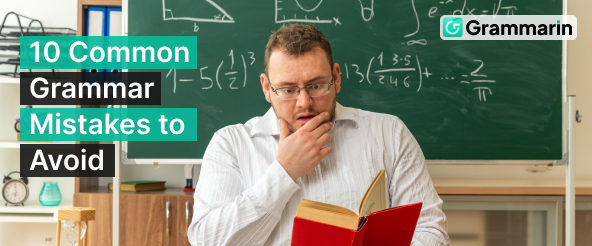Table of Contents
- Common Grammar Mistakes to Avoid
- Apostrophe Misuse
- Comma Splices | Run-on Sentences
- Dangling and Misplaced Modifiers
- Incorrect Usage of Homophones
- Writing Incomplete Sentences | Sentence Fragments
- Subject-Verb Agreement
- Verb Form Confusion | Mixed Verb Tenses
- Adverbs and Adjectives Misusage
- Double Negatives
- Lack of Parallelism or Parallel Structure
- Universal Solution for All Types of Grammar Mistakes
- Concluding Remarks — Final Verdict
10 Common Grammar Mistakes to Avoid
Grammar is one of the cornerstones of textual content. It makes or breaks the quality of written communication. That is why everyone puts great effort into formulating grammatically correct text.
However, grammar is a vast field because it involves different elements. That’s why various types of grammatical errors exist, which often overcomplicate things. So, beginners look for the most common grammatical mistakes to avoid. If you are one of them, this blog post has got you covered.
Common Grammar Mistakes to Avoid
Here, we’ll educate you about the ten most common grammar mistakes you must avoid, regardless of your writing niche. We’ll discuss each error with the help examples to help you better understand everything. And if you stick with us till the end, we have a pro tip for you that can instantly rectify all of your grammatical errors. So, let’s dive in here!

Apostrophe Misuse
The apostrophe is one of the most popular punctuation marks in linguistics. It serves two purposes:
- To write contractions—the shortened forms of words or groups of words.
- To showcase possessions.
However, this mistake has become one of the most common grammatical errors due to its frequent usage. For instance, beginners often get confused between words like ‘it’s and its,’ ‘your and you’re,’ and ‘1980’s and 1980s.’
The reason for such errors is simple—newbies don’t analyze and match the context of their situation with the concepts of contraction and possession. If this situation sounds familiar, you can prevent it by sticking to these suggestions:
- Avoid apostrophes when using possessive pronouns.
- Learn common contractions.
- Understand plurals vs. possession.
Comma Splices | Run-on Sentences
Sometimes, a sentence’s length keeps increasing due to excess information. So, to prevent readability in such situations, experts came up with the idea of combining two independent clauses (complete thoughts). But doing so requires following some guidelines.
For instance, the best way to join two independent clauses is to simply use a semicolon or a comma followed by a coordinating conjunction like ‘and’ and ‘but.’ However, most novices don’t understand this rule. They often forget to add a semicolon or proper coordinating conjunction when linking two independent clauses. As a result, they eventually fall prey to the issue of a comma splice, such as the following:
Comma Splice Example: Rachel went to the park, it was sunny.
But don’t worry—there is a fix for that. The best way to refrain from such an issue is to try one of the following recommendations:
- Split a sentence with a comma splice into two separate sentences.
- Use a semicolon.
- Add a coordinating conjunction after the comma.
However, make sure to use the correct coordinating conjunction. In the case of the above example, the appropriate coordinating conjunction will be ‘and.’ So, the above example will become: ‘Rachel went to the park, and it was sunny.’
Dangling and Misplaced Modifiers
In English, writers often use modifiers, either nouns or verbs, to describe or add detail to another word. However, when using modifiers, beginners usually either forget to include them or place them too far from the words they intend to modify. Such situations lead to two common issues:
- Dangling modifiers where the modified subject is missing.
Example: After finishing the homework, the TV was turned on. - Misplaced modifiers, where the placement of the modifier is incorrect for the word it modifies.
Example: Phoebe almost drove her kids to school every day.
As is evident, both examples create confusion. For instance, the example of the dangling modifier doesn’t contain any subject, which makes it unclear who turned on the TV.
Similarly, the wrong placement of the modifier (almost) makes it seem like Phoebe nearly did it but didn’t. So, to steer clear of such mistakes, consider the following suggestions:
- Identify the modifier first, which can be a word, phrase, or clause.
- If the subject is missing, add it and rephrase the entire sentence for clarity. For instance, the sentence ‘After reading the book, the movie was disappointing’ will become ‘After finishing the homework, I turned on the TV.’
- If the subject is present, check if the modifier directly points to the intended word. If not, change its placement. For instance, the sentence ‘Phoebe almost drove her kids to school every day’ will become ‘Phoebe drove her kids to school almost every day.’
- Make sure that the modifier you choose is correct for your context.
Incorrect Usage of Homophones
The English language contains many words that sound the same but have different meanings. These are called homophones. A few prime examples of homophones are as follows:
- Knight (a medieval warrior) and Night (the time of day when it is dark).
- Mail (post) and Male (gender).
- Peace (calmness) and Piece (a portion of something).
- Sea (large body of saltwater) and See (to visualize).
- Their (possessive form), There (a place), and They’re (contraction of they are).
- To (a preposition), Too (meaning also or excessively), and Two (the number).
- Right (correct or a direction) and Write (to compose text).
As you can see, each pair has a distinct spelling and refers to a different item, yet they all sound the same and are pronounced similarly. So, when it comes to writing content, newbies often get confused between such words, which eventually leads them to the incorrect usage of homophones.
However, there is a way to avoid this—simply familiarize yourself with the meaning of each word. By following this simple trick of the trade, you will always use the correct word for your context, which means you will never become a victim of the incorrect usage of homophones.
Writing Incomplete Sentences | Sentence Fragments
A sentence generally consists of at least three components: subject, verb, and object. The subject is the idea, person, place, or thing that does something. The verb is the action itself, and the object is the idea, person, place, or thing that receives the verb’s action.
Subject and verb are the most important elements because if a sentence doesn’t contain any of these, it will become an incomplete or fragment sentence. Here are some examples that best explain the issue of segment fragments:
Example With Missing Subject: Running through the park.
(Correct Form: She was running through the park.)
Example With Missing Verb: The book on the table.
(Correct Form: The book on the table is mine.)
Example With Both Missing Subject and Verb: After the storm.
(Correct Form: After the storm, we went outside.)
All three of the above-specified fragment sentences make it hard for readers to understand the intended context or meaning. So, to prevent such a confusing grammatical error, ensure that every sentence represents a complete thought and has a sentence and verb. To do so, you can proofread your text by reading it out loud or asking someone else to do that.
Subject-Verb Agreement
As we’ve already discussed in the previous grammatical error, subject and verb are two essential components of a sentence. Not only is their presence necessary in a phrase, but they should also be in sync.
This means that the subject and verb in a sentence must agree in numbers. If not, your phrase will sound awkward and incorrect. For instance, consider the following sentence:
Subject-Verb Disagreement Example: The flowers is blooming. (Wrong)
As you can see, the subject ‘flowers’ is plural, but its helping verb (is) is singular in the above example. So, the subject and verb are not syncing in numbers. And if you want to avoid this mistake, you only have to use singular verbs for singular subjects and plural verbs for plural subjects. Hence, the above wrong form of the sentence will become:
The flowers are blooming. (Correct Example of Subject-Verb Agreement)
Verb Form Confusion | Mixed Verb Tenses
Sometimes, writers rely on multiple verbs to convey information in a sentence. This situation gives rise to the problem of mixed verb tenses or verb form confusion. Here is an example that best demonstrates such a grammatical error:
Example: Joey was walking to the store and buys some milk. (Wrong)
The first portion of this example contains the ‘ing’ form of the verb, which is correct according to its helping verb. However, the second portion includes the ‘s/es’ verb form, which is incorrect because it should be in sync and according to the helping verb and subject.
This kind of grammatical flaw often confuses readers about the time frame of events. So, if you want to keep your write-ups away from such an issue, keep things simple by ensuring consistency across verb tenses in a sentence.
Here is how the implementation of this recommendation will look like for the above example:
Correct Form: Joey was walking to the store and bought some milk.
Adverbs and Adjectives Misusage
Besides the subject, verb, and object, a sentence sometimes contains an adverb and adjective as well. An adjective is a word that describes or modifies a noun, whereas an adverb alters an adjective, verb, or other adverb.
These two components help add clarity, description, precision, and variety to written communication. Therefore, they are essential to formulate high-quality write-ups.
However, sometimes, when people don’t understand adjectives and adverbs clearly, they misuse these components. A few prime examples of such situations are as follows:
Adjective Misuse Example: Chichi is a real good dancer.
Adverb Misuse Example: Android 19 ran quick to catch the bus.
In the first example, ‘real’ is not a correct adverb. Therefore, it can’t modify the adjective ‘good.’ Similarly, in the second example, ‘quick’ is not the appropriate adverb to describe how Android 19 ran.
So, to eliminate such issues from your writing, it is essential that you clearly understand the different forms of words and what adverbs and adjectives are. Here is what the correct form of the aforementioned examples will look like:
Correct Adjective Example: Chichi is a really good dancer.
Correct Adverb Example: Android 19 ran quickly to catch the bus
Double Negatives
Sentences come in different shapes and forms. However, three of the most common types are affirmative (also known as positive), negative, and interrogative.
Speaking of negatives, sometimes, people get carried away while using them and become victims of double negative sentences, such as ‘Chandler doesn’t know nothing’ or ‘Monica didn’t see nobody at the party.’
This situation especially occurs for those individuals who mostly write informal content. That’s because double negatives may be common and correct in informal settings, but this practice becomes a grammatical error in formal settings.
Therefore, you should avoid them, especially when writing content for the formal sector. The best way to do this is to always prefer a single negative. Doing so will prevent your write-ups from being ambiguous and guarantee clarity.
Here are the corrected forms of the above-specified double negative examples:
Correct Form: Chandler doesn’t know anything.
Correct Form: Monica didn’t see anybody at the party.
Lack of Parallelism or Parallel Structure
Sometimes, writers have to specify a list of items in a sentence. So, they use a comma to separate each item, which is appropriate. However, they fail to follow the same structure when it comes to the parallelism of grammatical forms. As a result, they fall prey to the lack of parallelism error. This situation is widespread among novice writers or language learners. And here is how the sentences formed with this grammatical mistake look like:
Lack of Parallelism Example 1: She likes reading, swimming, and to hike.
Lack of Parallelism Example 2: For dinner, I had a salad, grilled chicken, and dessert was chocolate cake.
Fortunately, there is a more straightforward fix for this error. All it requires is ensuring that all items share the same grammatical forms (gerund, noun, etc.) and following consistency in comparison and clauses. For instance, instead of writing sentences by following the aforementioned approach, stick to this practice:
Correct Example of Parallel Structure: She likes reading, swimming, and hiking.
Correct Example of Consistency in Clauses: For dinner, I had a salad, grilled chicken, and chocolate cake for dessert.
Universal Solution for All Types of Grammar Mistakes
So far, you may have understood that to avoid all the ten common grammatical errors, you need a proper understanding of different methods and techniques. This may seem easier to accomplish, but it’s not.
For this purpose, we have brought a universal solution in the form of a grammar checker that can instantly correct all types of grammatical errors. Since such a tool works through artificial intelligence, you don’t need to memorize any language rules.
It can automatically suggest the correct form of all grammar mistakes in a flash. You just need to proofread your text through this tool, which you can do by simply entering your content.
Concluding Remarks — Final Verdict
To sum things up, grammar plays a crucial role in the effectiveness of any written communication, be it an email, report, or some other document. Therefore, you should avoid all the grammar mistakes. Otherwise, you won’t be able to improve your writing and sound professional. But perfection in grammar takes time. So, make sure to keep writing and reading well-written content.


